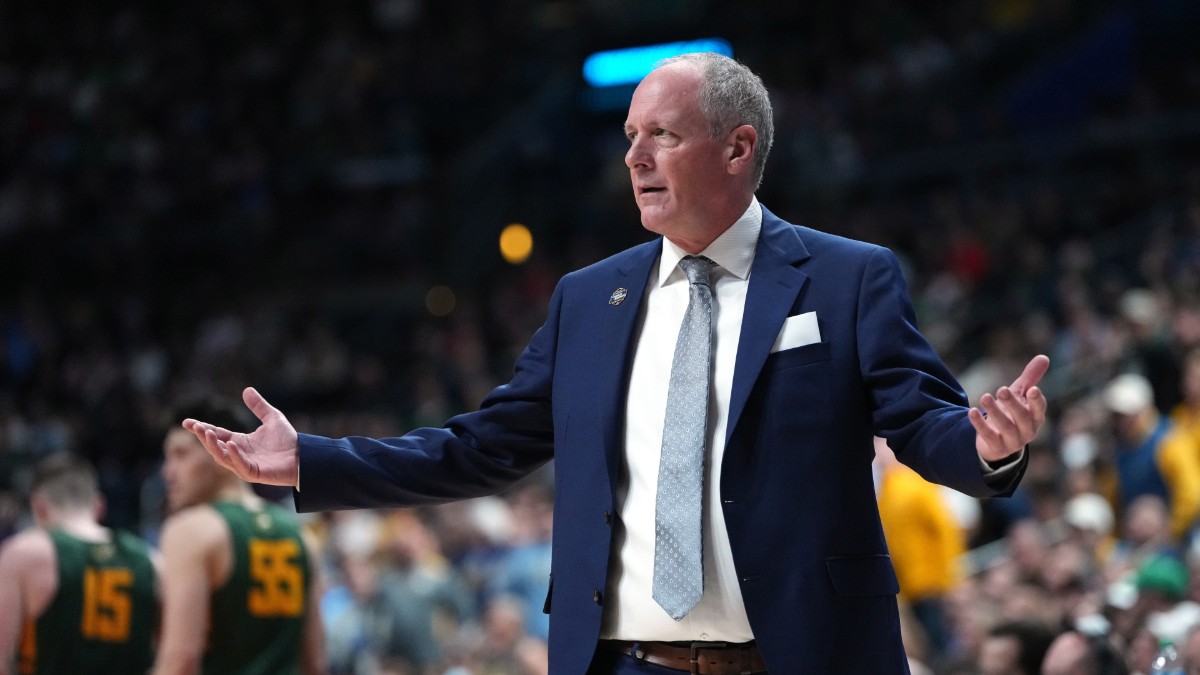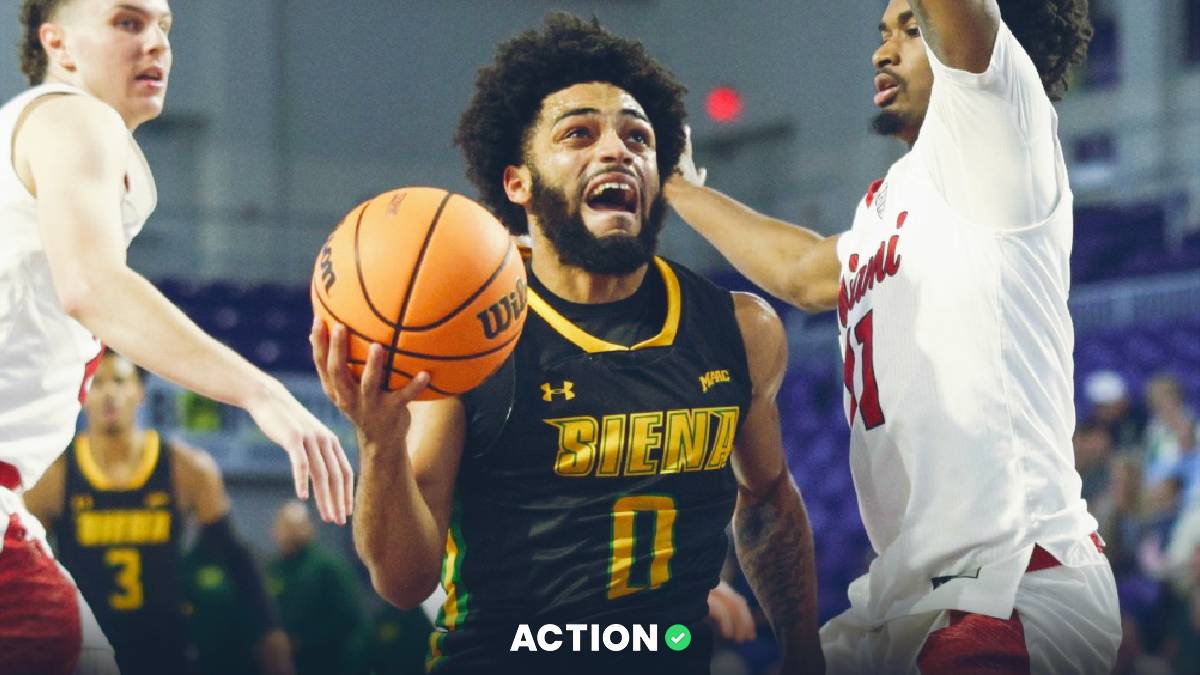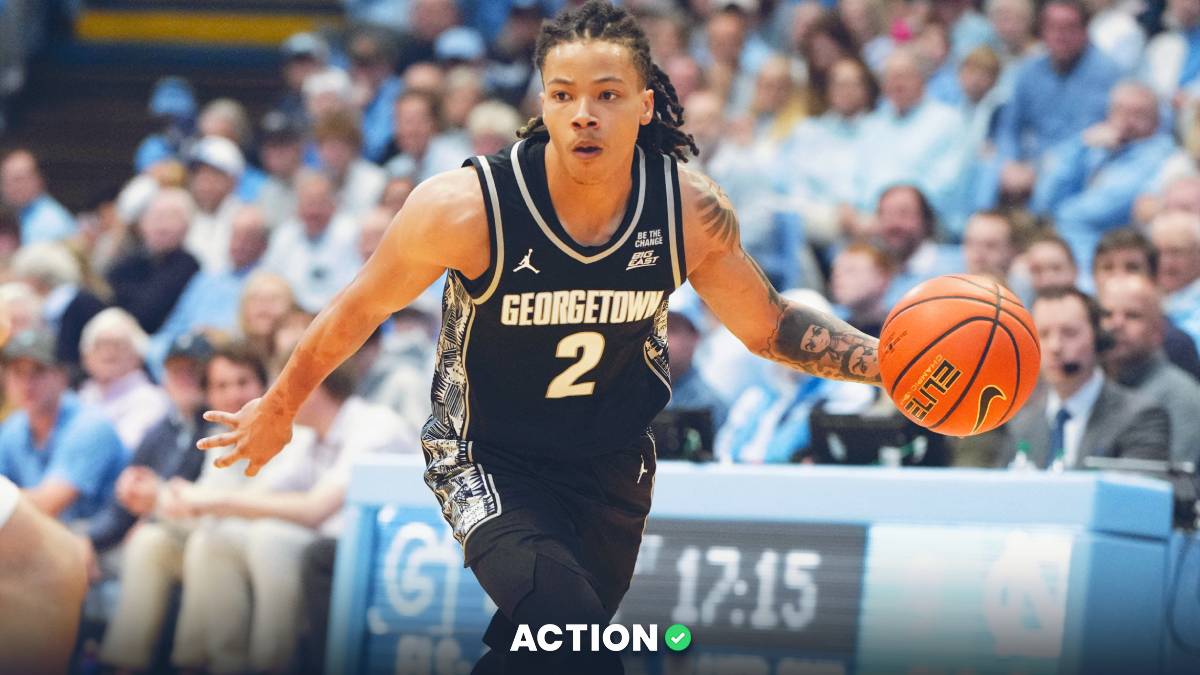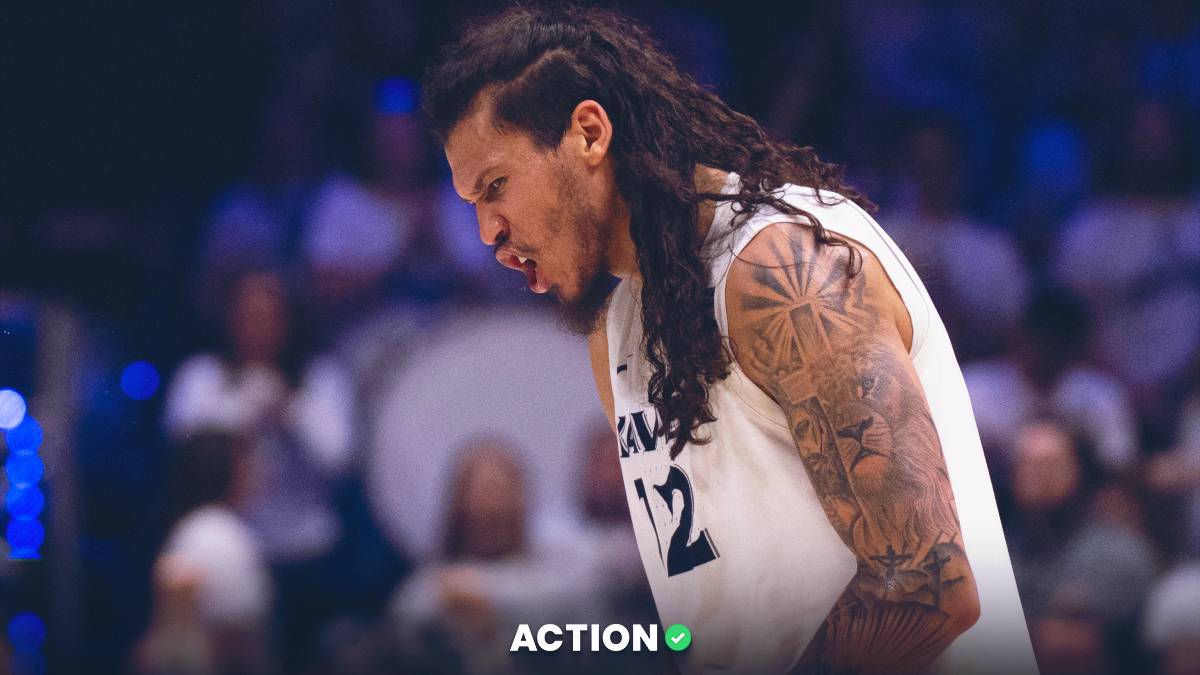I grew up in Southern Vermont, in the small town of Manchester.
And I grew up on Catamount basketball.
Following the Cats, I learned to love and appreciate all the America East squads. I have local connections with many of these places, having lived in half of them. I love Burlington, Durham, Albany and Binghamton, plus my dad currently lives up near Orono.
My favorite connection: Maine’s point guard and the league’s reigning Defensive Player of the Year, Kellen Tynes, is from Dartmouth, Nova Scotia, where I currently reside.
So, I feel close to these programs. When I became a sports writer, I loudly advocated to cover the league as much as possible, and I’ve been doing so for The Action Network for four years.
I know this league like the back of my hand now. I have a great read on every team and connections with most coaches and AmEast media pundits (there are probably around 12 of us).
I’ve leveraged those connections into media credentials for Vermont’s America East Tournament games at Patrick Gymnasium in Burlington. I'll be our Boots-On-The-Ground guy for (hopefully!) all three tournament games Vermont hosts.
So, you can basically call me the Collin Wilson of America East Basketball.
As you can probably tell, these AmEast preview articles are among the most important pieces of content I write all year. I pour my heart and soul into them, and I thank you in advance for reading any part.
Without further ado, let’s dive into how I’m betting the America East Conference Tournament.
America East Odds
| Team Name | Odds (Via FanDuel) |
| Vermont | -280 |
| UMass Lowell | +360 |
| Bryant | +1200 |
| Maine | +4000 |
| New Hampshire | +4500 |
| Binghamton | +5000 |
| UMBC | +10000 |
| Albany | +10000 |
America East Bracket
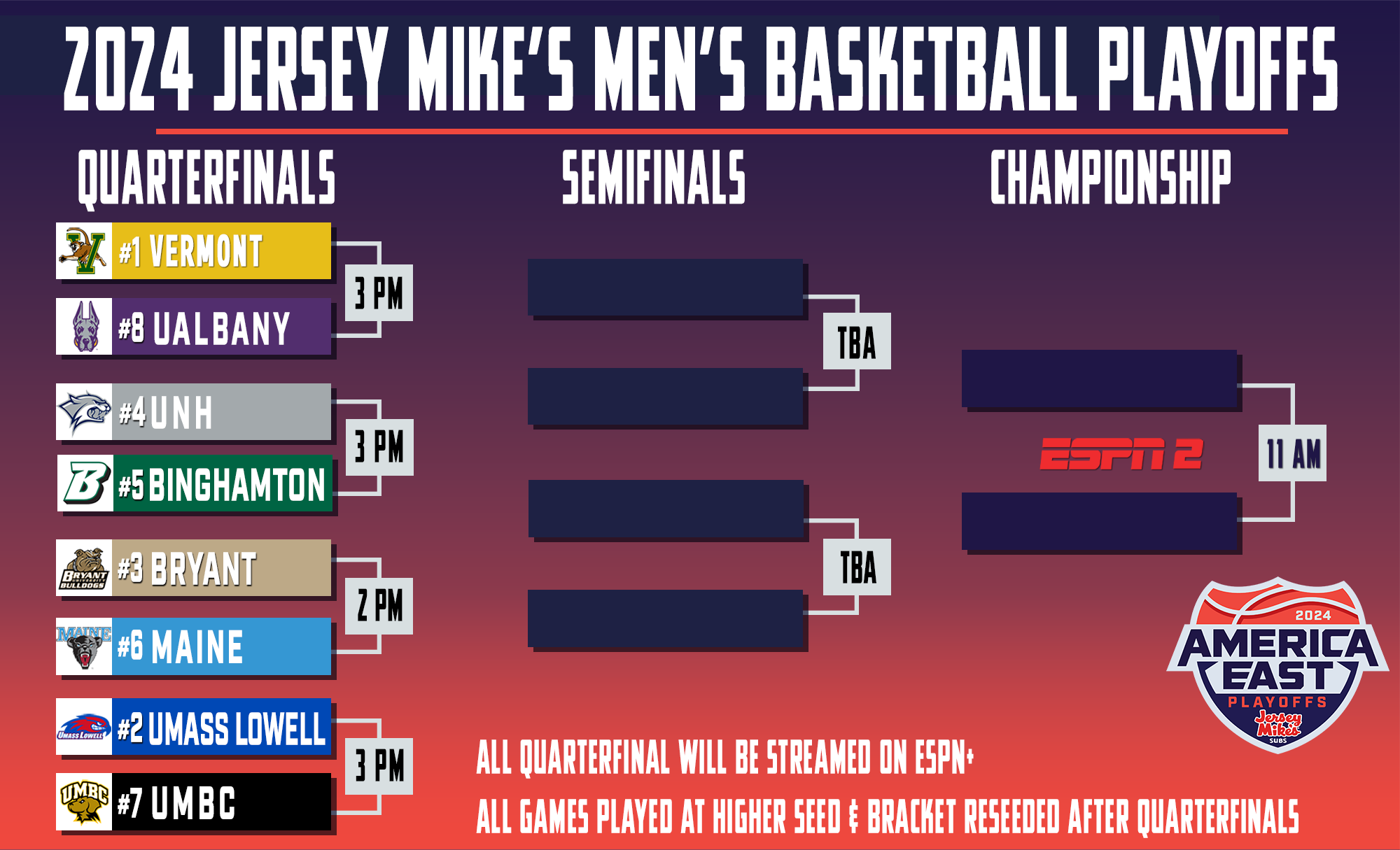
The higher seed hosts each matchup at their home venue. Teams are re-seeded after each round, with the highest remaining seed facing the lowest remaining seed and so on. The title game will be aired live on ESPN2 at 11 a.m. ET on Saturday, March 16.
Lay of the Land
I don’t want to get poetic.
But I am from Vermont, where Robert Frost penned his best work, so screw it.
Apologies for the analogy.
I moved around plenty as a kid, chasing an Alpine Ski Racing dream. At one point, I attended six different schools and raced for six different mountains across six consecutive years. I continued traveling and moving around in my adult years and have lived in nearly 25 places.
I’ve become almost addicted to change in the process. I love and appreciate new places, environments, people, experiences, etc. I live for Spring and Fall, specifically for the changing of seasons.
And that’s why I’ve adored this season of America East basketball.
The last decade of AmEast basketball has been defined by defense and shot selection, at least relative to other low-major leagues. Most teams ran methodical offenses while focusing on fundamental rebounding and disciplined defense.
But Bryant's injection into the league last year and semi-recent coaching changes at New Hampshire, Albany, and UMBC have flipped the league on its head.
The Bulldogs run a transition-on-steroids attack. Nathan Davis has turned New Hampshire into a track team. Dwayne Killings has slowly upped the Great Danes’ pace of play by recruiting some of the most dynamic, speedy players in AmEast history. Jim Ferry is a long way from Ryan Odom, and he leaned into pace and shooting this season with a new-look roster.
Suddenly, America East basketball is about pushing the pace, letting it fly, and eschewing prevention in favor of all-out assault.
Last season, the America East ranked 20th among 32 conferences in tempo. It ranked 28th in the two prior years. It ranked 31st in 2019.
This season, America East games boast the fastest pace of play, averaging over 70 possessions per game. Four AmEast teams average double-digit fast-break points per game, and three rank top-10 nationally in transition frequency. Three squads rank top-10 nationally in adjusted tempo (Bryant, Albany, UMBC), another one in the top 25 (New Hampshire) and one more ranks in the top 60 (UMass Lowell).
For an adept example of America East basketball this year, check out the early February game between UMBC and Albany that featured 37 transition possessions, 37 fast-break points, 153 field goal attempts, 55 3-point attempts, 116 paint points, 40 free throws, and 216 points…
In regulation!
It's been a fun year to be an America East fanatic.
And it’s been a strange year, specifically from an injury perspective.
Albany never got former America East Rookie of the Year Justin Neely back from ACL injury, lost former All-Rookie Marcus Jackson to a hand injury, and last year’s Rookie of the Year Jonathan Beagle left the program for personal reasons.
Binghamton’s dealing with an injury to superstar point guard Symir Torrence. In a recent post-game presser, Coach Levell Sanders spoke very vaguely about his injury:
“We gotta be better as a medical staff of giving information when it needs to be given,” or whatever that means.
NJIT lost uber-efficient stretch-five Kjell De Graaf to a season-ending knee injury, opening the door for rookie point guard Tariq Francis to reach historic heights.
But the Kareem Abdoul-Coulibaly news at Lowell takes the cake.
The potential Player of the Year candidate and Lowell’s most vital player suffered an injury against Saint Peter’s in late November and missed the next nine games. He then returned and played 15 OK minutes a night for three games before piecing together three shots across a hobbled 18 minutes against Binghamton and Vermont, literally laboring up and down the court.
He never returned and likely won’t for the tournament.
During this wild saga, we didn’t hear a peep from Coach Pat Duquette or the program concerning the injury. We were left in the dark, only speculating about what happened.
It’s been a wild year. There was even a logo change – the America East is now known as the fastest league with the worst emblem.
Looks like a rip-off of the I-95 sign.
Still, the more things change, the more they stay the same.
The Catamounts won their eighth consecutive regular-season title behind a 15-1 conference record.
Yet Bet365 dropped a ridiculous, ludicrous, hilarious opening number of +100 to win the tournament.
I obliterated that line. I project they win the conference closer to 60% of the time, so I got a steal considering the -150 fair price.
Unfortunately for everyone else who doesn’t follow us on Twitter or in The Action Network App, that number got destroyed, as the Cats now sit around -270 across the market.
We’ll talk about other teams and angles with better value because Vermont's unplayable at that number. Still, for all intents and purposes, I’m picking the Catamounts to cut down the nets.
And that’s because John Becker stood pat in the face of change.
Despite the league changing underneath them, the Cats still refuse to be sped up.
They still play languidly, running a methodical five-out motion offense that foregoes offensive rebounds to get back on defense and prevent transition run-outs.
Becker talked about his transition defensive mentality a few years ago.
So, even as more teams have emphasized shooting transition 3s, Vermont still focuses on gunning toward the basket before fanning out to shooters.
The style is dynamite. Vermont’s consistently been an elite transition defense during the Becker era.
And even as every other league team started sprinting toward the Cats, Becker upped the ante and double-down on his style.
And, per usual, he won.
In fact, the changing of the AmEast guard worked in Vermont’s favor. None of these super-transition-reliant teams can generate transition offense against the conference kings, stifling everyone else’s offense at the outset.
The league ran right into the Cats’ hands.
They lead the nation in fast-break points per game allowed, under six. They rank above the 70th percentile of D-I teams in transition PPP allowed, under 1.00. They’ve allowed double-digit fast-break points in only three games, fewer than five in six, and zero in four.
It’s partially resulted in Becker’s best defensive team ever. The Cats rank in the top 60 nationally in defensive efficiency and lead the conference in effective field goal percentage allowed (45%), 2-point shooting allowed (44%), and paint points per game allowed (30) while never fouling and rebounding everything.
At the point of attack, Shamir Bogues is the best defensive guard Vermont has ever had. And at the anchor, Ileri Ayo-Faleye is a shoo-in for Defensive Player of the Year.
Those two rank first and second among AmEast players in DBPR, respectively.
Ileri is legitimately astonishing to watch play defense. He makes more impactful plays with each passing game.
He had four blocks in Vermont’s title-clinching game against Lowell. Vermont’s defense is 12 points per 100 possessions better with him on the court. The Cats’ rim defense is eight percentage points better, and their mid-range defense is 12 points better.
His play-by-play stats are similarly insane, given he ranks above the 75th percentile of D-I players in post-up PPP allowed (.70, 77th), roll-man PPP allowed (.36, 95th, first in AmEast), and isolation PPP allowed (.39, 93rd percentile).
Ayo-Faleye defends at all three levels and is among the most versatile, athletic players I’ve ever seen in the America East conference.
He’s even improved monstrously on the offensive end.
The most significant change Ileri made was developing a 3-point shot. He’s only 14-for-46 for the year (30%), which isn’t excellent or high-volume. Still, it’s been important because defenses have to somewhat respect the shooting threat, allowing him to stay on the court longer in Becker’s five-out motion – Coach doesn’t have to sacrifice spacing for defense anymore.
Ayo-Faleye also uses the shooting threat to pull less athletic big men out of position defensively to either cut behind toward the rim (1.33 PPP, 73rd percentile) or drive past them and gain leverage in post-up sets (1.00 PPP, 80th percentile).
I seriously think Ileri has a case for AmEast Player of the Year. He’s equally as impactful on the offensive end now.
Check out his total two-way on-off splits:
| UVM | IAF On-Court | IAF Off-Court | Diff. |
|---|---|---|---|
| Net Rating | 18.4 | 1.2 | 17.2 |
| Offensive Rating | 113.1 | 105.6 | 7.5 |
| Defensive Rating | 94.7 | 104.4 | -9.7 |
| eFG% | 55.8% | 48.6% | 0.072 |
| eFG% Allowed | 44.6% | 49.8% | -5.2% |
| At-The-Rim Shooting | 68.7% | 58.4% | 10.3% |
| At-The-Rim Shooting Allowed | 54.4% | 59.6% | -5.2% |
| 3P% | 37% | 30.2% | 6.8% |
| 3P% Allowed | 31.8% | 32.6% | -0.8% |
Combine his offensive and defensive numbers, and Ayo-Faleye is the America East’s most impactful player by overall BPR — he's the most valuable player for the conference’s best team. Unfortunately, he probably doesn't have the counting stats to get the votes (seven points, six rebounds, one block per game).
Let’s talk about the Vermont offense a bit more.
At the beginning of the year, I wrote that I was weary about the new-look backcourt’s ability to cut or shoot as effectively as last year’s.
At their best, these Cats are as good as last year’s squad.
Vermont is a perimeter-oriented offense, and these guys can still shoot the rock, albeit not quite as effectively as last year’s team.
But just as importantly, when Vermont doesn’t generate an excellent open shot, the Catamounts shift into ball-screen mode, looking for frontcourt pieces Ayo-Faleye, Matt Veretto, or Nick Fiorillo on the hard roll. And if that doesn’t work, those three will dish the ball to cutters off the short roll.
The Catamounts excel in both sets, leading the AmEast in cutting PPP (1.32) while ranking third in roll-man PPP (1.08) – of note, Veretto was the second-best roll-man in the conference by PPP (1.43).
Vermont led the league in 2-point shooting for a reason (55%).
However, these Cats are prone to droughts and long stretches of stale offense, and their overall conference-play metrics are down substantially from past years.
| UVM Team | OE | eFG% | 3P% |
|---|---|---|---|
| 2022 | 120.3 | 60.9 | 41.0 |
| 2023 | 116.4 | 57.5 | 37.7 |
| 2024 | 109.4 | 52 | 32.8 |
We saw that in Vermont’s only conference loss to NJIT, with 23 first-half points. We saw it against Bryant, with 25 first-half points. We saw it against Binghamton, with 22 first-half points.
However, the difference-maker is that this is also Becker’s deepest team ever.
Vermont ranks top-50 nationally in bench minutes while leading the league in bench scoring – Becker’s never had a top-70 bench minutes team. Nine players play 15 or more minutes per game, eight shoot over 30% from deep, and eight have led the team in scoring at least once this year.
That depth has shown up in two areas.
First, the new league schedule has given Vermont a huge advantage, as the AmEast moved from Wednesday-Saturday league games to Thursday-Saturday. Thus, the Catamounts were almost always fresher than their opponents on less-than-48-hour turnarounds.
I texted Coach Becker about that, wondering if he specifically recruited extra depth for this reason. His response:
“No, they didn’t change the conference schedule until league meetings in June. However, I do agree it should be an advantage for us.”
I think it’ll help in the tournament, too.
Second, the Cats have taken off in the second half of games this season, recording a top-30 second-half scoring margin nationally.
They always have another guy they can lean on when someone else isn’t scoring.
Aaron Deloney is a human microwave when playing with aggression and confidence, as evidenced by his 33-point outburst against Lowell:
Shamir Bogues can bully-ball his way into 20 points on any given night, as evidenced by his game-winning bucket over UMBC:
TJ Long has been a dream transfer as a wing scorer, canning 36% of his triples, including several late-game miraculous shots, as evidenced by this four-point play to beat Yale:
Jace Roquemore is an excellent shot-maker, sneaky-good dribble-penetrator, and playmaker when leading the second unit. The same goes for TJ Hurley.
Ayo-Faleye is a stud, Veretto is among the best pick-and-pop bigs in the mid-majors with legitimate NBA range, and Fiorillo is a savvy roll-man low-block player.
Any of these guys can score 20 points or make six triples on any given night, and that depth combined with stifling defense should be more than enough for the Cats to overcome any obstacles.
It’s exactly how Vermont beat top opponents Lowell and Bryant on the road in less than 48 hours in late January, with the former win coming in overtime. It’s exactly how the Cats dominated Lowell in the regular-season title-clinching game despite Veretto and Hurley nursing injuries.
And it’s precisely how Vermont will win its third consecutive America East Tournament.
Pick: Pass on Vermont Futures At Current Price
I thought about UMBC, Binghamton, and Maine as my long-shot flier bet in the conference, all sitting around 50-1 in the markets.
But I ultimately settled on Maine for a few reasons:
- Binghamton’s star point guard and most important player, Symir Torrence, is battling an injury. Although Torrence is officially listed as day-to-day, head coach Levell Sanders has shrouded the injury in mystery, which gives me little confidence.
- I don’t trust UMBC to get enough stops, even though the Retrievers are fascinating because they’ve steadily improved as the season has progressed and played the top of the league very tough.
Maine had a disappointing year. I had so much preseason hype for the Bears, and we all fell flat on our faces.
Unfortunately, I think Coach Chris Markwood and Co. showed they aren't quite ready to contend yet, even as they’ve steadily improved over the past two years. The Bears lack poise and confidence in crunch-time situations.
For example:
- They blew a second-half lead against Vermont
- They blew a horrific 11-point lead with six minutes left at home against UNH
- They blew a late two-point lead against UMBC
- They blew a six-point second-half lead against New Hampshire
- They blew a late six-point lead against Binghamton
- They collapsed late against Albany but managed to sneak away in overtime
Eight of Maine’s nine losses have come by a combined 28 points, or 3.5 per game. Three came by one possession.
But close-game variance usually comes around.
And Maine’s luck has turned down the stretch. The Bears pulled off a second-half comeback against Bryant, held off UMBC and NJIT late, did win that overtime game against Albany despite the collapse, and survived a 10-point second-half melt in the regular-season finale against Lowell to pull out a monster win.
The Markwood-Tynes defense is still elite, fully meeting my lofty pre-season expectations. The Bears are an aggressive perimeter defense, leveraging the swarming backcourt of Tynes and Jaden Clayton to pressure ball-handlers, jump passing lanes and force turnovers.
The Bears rank second in the conference in defensive efficiency and forced the highest turnover rate for the second consecutive season. They are a lethal ball-screen coverage defense, which is obvious when you have Tynes at the point of attack. They effectively deny cutters by jumping gaps while using defensive IQ to scramble and swarm the paint.
They rank only behind Vermont in fast-break points per game allowed, which is tough to do in the America East. And they’re only behind Vermont in second-chance points per game allowed, cleaning the boards effectively.
While you’d think Maine is getting lucky because opponents are shooting 29% from 3, ShotQuality projects the Bears as a 30% 3-point defense because they lead the league in Open 3 Rate allowed, are second in 3-point rate allowed, and are excellent at defending secondary actions on the perimeter (top-15 nationally in off-ball screen PPP allowed).
The problem is, as it always is in Orono, Maine can’t score.
But it’s not even that the Bears can’t score as much as they consistently get away from what works, with Markwood failing to scheme open his best players.
And what works is Tynes running ball screens with Peter Filipovity and Kristans Feierbergs, his two Eastern European big men.
Markwood runs a ball-screen continuity offense, which means they run a high pick-and-roll on the left, then a high pick-and-roll on the right, rinse and repeat.
Tynes has improved as a ball-screen initiator this year, while Filipoivty is among the most versatile interior scorers in the league. Filipovity is an elite bag man with various post moves, and he’s versatile enough to dribble-penetrate, play-make, and shot-create on his own. He sometimes runs some cool Filipovity-Feierbergs ball-screen sets, with Feierbergs being an elite roll-man in his own right.
Still, the ball finds its way to Quion Burns and AJ Lopez on the wings far too often – two sloppy ball-handling, poor decision-making, lousy shot-making wings. Neither should have a possession rate over 21%, yet both do.
Defenses probably realize Maine's strengths and game plan to force the ball toward the wing. That’s an easy scout, right?
Yes, but Markwood is an elite head coach, and he should be able to counter adjustments to get Filipovity on the low block.
All that said, Maine is one hot shooting night away from pulling off any upset.
The Bears' defense is so good that if Lopez and Burns actually make shots off wing passes from Tynes, Maine can out-score any opponent. That’s unlikely because the Bears are so inept and shot-creating and shot-making, but they are 8-3 in games where they shoot 35% from deep, compared to 6-13 otherwise.
Plus, Markwood managed to get Filipovity open enough in that regular-season finale win over Lowell to get him a career-high 27 points, including several huge late-game buckets. The Bears won despite shooting 4-for-20 (20%) from 3.
So, if Maine can pull off the first-round upset over Bryant – and I think it has a good chance because A) the Bears have already beaten the Bulldogs by holding their transition-reliant offense to seven fast-break points while forcing 16 turnovers and B) I’m hearing rumors that Player of the Year candidate Earl Timberlake broke his shooting hand against NJIT – I’m willing to take my chances against Vermont.
Maine held a second-half lead at Patrick this year. The Bears can compete because they match up pretty well, given they’re an elite perimeter defense that can counter Vermont’s five-out motion and an even better ball-screen coverage squad that can cover Vermont’s secondary actions. Meanwhile, the Cats are vulnerable against the pick-and-roll, so the Bears’ ball-screen motion sets could play.
Perhaps more importantly, Maine’s offense isn’t transition-reliant like many other conference teams. The Bears want to slow the game down and try to face Vermont in a lower-possession, half-court game script, which ironically works against the Catamounts.
Ultimately, the Bears need to shoot better than the 10-for-32 (31%) from 3 they posted in two head-to-head matchups, but I’ll take my chances at this number.
Pick: America East Tournament Champion — Maine (+5000)
The Cats should be around 15-point favorites in their first-round matchup with Albany, and I’m happy to lay that.
Look, the Danes are crazy athletic. Sebastian Thomas is among the quickest guards I’ve seen at this level. Tyler Bertram, Amar’e Marshall and Aaron Reddish are three quick-twitch guards who ruthlessly attack the rim but can score from three levels.
But Albany is by far the worst defensive team in the conference.
The Danes have actually been crazy lucky on that end this season, with opponents shooting under 30% from 3. While they play a drop-coverage defense that effectively denies 3-point opportunities, they also rank last in the conference in Open 3 Rate allowed. ShotQuality projects them closer to a 33% 3-point defense based on the “quality” of attempts allowed.
Yet Albany still ranks last in the AmEast in defensive efficiency because its interior defense is so bad that any 3-point variance, regression, non-regression, or whatever doesn't matter.
Once Beagle left the program, Killings began playing small-ball lineups with 6-foot-7 Aaron Reddish at the five. He tried to pull a Nate Oats, overcompensating offensively for no rim protection or rebounding.
It didn’t work, as Albany lost eight of 10 down the stretch by allowing 44 paint points per game on 59% shooting from 2-point range.
Albany allows six more paint points per game than any other America East team (42), and the Danes' 2-point shooting percentage allowed is four points higher than any other conference squad (58%).
They’re horrible against cutters, roll-men, and other secondary actions designed to attack the rim. They’re also awful post-up defenders, where Marshall was abused as the small-ball interior anchor.
Altogether, Albany ranks sub-320th nationally in at-the-rim PPP allowed (1.17) on a nationwide-high 27 at-the-rim field goal attempts.
Yes, Vermont is a perimeter-oriented offense. But as mentioned, the Cats will shapeshift into ball-screen mode when the perimeter isn’t open, targeting Veretto or Fiorillo on the hard roll and back-door cutters off the short roll.
So, predictably, across two head-to-head meetings with Albany, Vermont scored a whopping 49 points on 29 cutting and roll-man sets – an absurd 1.7 PPP – en route to 86 paint points on over 70% 2-point shooting.
And When Albany tries to overcompensate for its pathetic defense with its electric attack – which ranks third in the conference in offensive efficiency – the Danes are still running an up-tempo, transition-heavy, rim-running attack into the league’s best interior defense and the nation’s best transition denial defense.
You can’t beat Vermont that way.
The Danes went 6-9 ATS on the road this year and lost by 22 the last time they visited Patrick, and that was with Beagle.
I can’t see them staying within 20 this time around.
Pick: Vermont ATS vs Albany in First Round
I’m buying Binghamton.
I thought the Bearcats were undervalued before conference play kicked off, as they were due for some two-way shooting regression.
Well, they started the conference season 0-5, which sucked.
But they finished 7-4 to post their first winning conference season since 2009. Three of those losses came against the league’s top three, and the other came against UMBC, but only because the Retrievers shot 12-for-24 (50%) from 3.
So, the positive regression train has pulled into Bearcat station, and I'm thrilled. They’re playing great basketball right now, and we’ll talk about why after we discuss why I’m selling New Hampshire.
New Hampshire got crazy lucky for most of the year. Opponents shot 28% from 3 across the season's first 23 games despite the Wildcats ranking dead last in the AmEast in 3-point rate allowed and Open 3 Rate allowed. Among AmEast teams, only UMBC allows more unguarded catch-and-shoot jumpers per game than UNH’s 9.5.
But, finally, all the negative regression came at once.
New Hampshire lost its final four regular-season games because opponents canned 42 of 100 3-point attempts, a 42% mark more characteristic of the Wildcats’ defense.
I’m happy that regression caught up to them because the truth is that New Hampshire is a bad all-around defense.
The interior defense is horrendous.
When you watch New Hampshire, you want to watch Clarence Daniels, the dominant-and-versatile three-level scoring big man who drops 20 points per game while crashing the boards harder than any conference player. And he leads a very versatile, dynamic, pace-and-space offense alongside excellent complimentary frontcourt pieces Jaxson Baker and Trey Woodyard.
But while Daniels defends, the other guys don’t.
Baker and Woodyard are two horrific interior defenders who consistently get bullied by opposing frontcourts. The Wildcats are also aggressive defenders that try to jump passing lanes and force turnovers to generate run-outs, leaving them vulnerable on the interior.
The result is a defense that allows over 36 paint points per game, ranks second-to-last in the AmEast in 2-point shooting allowed (55%) and ranks sub-350th nationally in post-up and roll-man PPP allowed.
New Hampshire’s bad at defending the perimeter and the interior, and the former luck has finally come crashing down, revealing the Wildcats’ true colors.
Let’s talk about this specific matchup.
I alluded to the pace-and-space offense that Coach Davis has built. And, including the Daniels-led frontcourt, New Hampshire has some really fun players, like quick-twitch point guard Ahmad Robinson, who’s dropping 15/5 this season.
Robinson pushes the pace, and the Wildcats try to generate great perimeter looks or post-up opportunities, specifically with low-block merchant Daniels.
But they don’t excel at anything. They’re merely average in transition efficiency despite creating plenty of opportunities. Robinson and Daniels have turnover issues, so the team ranks last in the conference in turnover rate. They’re seventh in the league in Open 3 Rate, with 60% of catch-and-shoot jumpers coming with a hand in their face.
That doesn’t inspire confidence against Binghamton, which boasts a rock-solid transition and perimeter defense behind lengthier two-way versatile wings and an even better interior defense anchored by big man Tariq Balogun, who leads the conference in post-up PPP allowed (.42).
So, Binghamton ranks second in the league in paint points per game allowed (31), third in transition PPP allowed (.99), and second in Open 3 Rate allowed – which is everything the Wildcats want to do.
Additionally, Bing's versatile two-way wings should dominate on the offensive end.
Binghamton has the nation’s cut-heaviest offense. Nobody runs cut-to-the-rim sets more than the Bearcats, and only three teams have a higher rim rate. They leverage Torrence’s elite vision – he ranks fourth nationally in assists per game this year (7.5) – to hit cutters in stride.
Specifically, Torrence usually hits two-way versatile wings Tymu Chenery and Gavin Walsh.
Chenery has been a revelation this season as a 15-point-per-game slashing wing that dominated off the bounce and on those cutting sets (1.33 PPP, 71st percentile) to shoot 62% from inside the arc.
Walsh ascended as an All-Rookie player during Binghamton’s late-season surge, averaging 11 points per game across the final five.
Boy, that sure sounds tasty against New Hampshire’s lifeless, lackadaisical, non-existent interior defense.
The Wildcats rank second-to-last in cutting PPP allowed (1.2). In two head-to-head meetings this year, the Bearcats scored 28 points on 24 cuts (1.16 PPP).
There is a caveat.
These two split the regular-season series. However, New Hampshire squeaked an overtime victory in Durham when Chenery was hurt, while Binghamton won convincingly at home when Torrence was out.
However, Binghamton needed a 10-for-22 (45%) 3-point shooting night to overcome 21 turnovers, and I’m unsure if primary spot-up weapons Armon Harried and Dan Petcash can sustain that.
So, I really need Torrence to be available to make this play viable.
If Torrence is handling the rock, those turnover issues are minimized, the wings can cut to the rim freely, the other wings could still make shots against a poor 3-point defense, and the Bearcats will roll the regressing Wildcats.
As it stands, Torrence is day-by-day, and his status should be updated later in the week. So, keep a close eye on Twitter (you can follow me for updates) and fire away on the Bearcats as projected five-point road dogs if he's confirmed healthy.
And if either team wins their first-round matchup, I’d look to back Binghamton or fade New Hampshire in the semi-finals. I think our Buy/Sell angle goes beyond Round 1.
Pick: Binghamton ATS vs New Hampshire in First Round IF Symir Torrence Plays
I’m unsure if Bryant can get past UMass Lowell if the chalk holds in the first round.
Lowell figured out how to play without Coulibaly. Duquette has tweaked his flex-motion offense to relentlessly attack the interior, draw fouls, and crash the offensive boards – specifically behind two walking frontcourt matchup problems in 6-foot-7 Quinton Mincey (14/6 on 60% 2-point shooting) and 6-foot-8 Cam Morris (11/6 on 55% from 2 and 40% from 3).
And the Hawks swept Bryant.
The best thing to happen in Smithfield this year was the (some would say forced) resignment of head coach Jared Grasso. Phil Martelli Jr. abandoned his predecessor’s goofy extended hole-filled pressure zone in favor of an aggressive, ball-screen denial that forces plenty of isolation sets and rim funneling, where the Bulldogs then leverage their unmatched wing athleticism and talent to viciously deny the rim.
There are some Houston ball-screen blitzes, Iowa State rim denial, and Virginia pack-line elements baked in, but the result is an attacking defense that leverages athleticism in scrambling and recovery to swarm the paint and swat shots. Daniel Rivera, Connor Withers and Timberlake are obliterating every layup attempt into the second row – Bryant leads the league in block rate by a mile (14%).
Ultimately, the Bulldogs are the league’s second-best 2-point defense (46%), right behind Vermont.
But the scheme's inherently confrontational nature feeds into Lowell’s two favorite paths to offense: free throws and offensive rebounds. The Bulldogs will either foul or leave the glass open when attacking — they’re among the worst rebounding teams in the conference.
Lowell generated 15 second-chance points and 29 FTAs in the first meeting, and then 26 FTAs in the rematch.
However, I’d like to think if Bryant got another crack at Lowell, some positive shooting regression would come. The Bulldogs shot 7-for-38 (18%) across both meetings, while Lowell shot 18-for-39 (46%).
Of course, the Timberlake injury is significant, but Lowell could be without top interior defender Max Brooks, who missed the regular-season finale.
But that’s neither here nor there.
Because Bryant is never getting past Vermont. Never in a million years.
The Bulldogs are 0-4 SU and ATS against the Catamounts over the past two seasons, and there are three reasons why.
First, Bryant’s swarming, aggressive, attack-and-recover defense is vulnerable to crisp perimeter passing and deadly weak-side shooting, which the Catamounts personify. Vermont never turns the ball over while working the ball around the perimeter searching for open 3s, while Bryant ranks second-to-last in the conference in Open 3 Rate allowed.
Second, Bryant’s significantly improved defense still struggles to contain efficient secondary motion-based sets. You can beat the Bulldogs if you move the ball faster than they recover.
As mentioned, Vermont loves running those interior secondary actions, and it’s cooked Bryant in that regard. In the two head-to-head meetings this year, the Cats scored 29 points on 20 post-up and cutting sets (1.45 PPP).
Third, and finally, the Bulldogs are simply too transition-reliant to exploit Vermont’s impenetrable transition defense.
Bryant is among the most lethal open-court offenses in the sport. Only Western Kentucky scores more transition points per game than Bryant, and the Bulldogs generate 1.15 PPP.
But in four games against Vermont over the past two seasons, they’ve scored 52 points on 57 transition possessions, good for a pedestrian .91 PPP.
Bryant will never beat Vermont, and if this championship matchup happens, I’ll happily double down on my Catamount future – especially if Timberlake remains shelved.
Pick: Vermont ATS vs Bryant in Potential Championship Matchup
I have to say, I don’t know what will happen in the 2-7 matchup.
But it’s such a fascinating game that I feel compelled to share a few thoughts.
Initially, I thought UMBC was just getting lucky from 3 during its late-season surge. The Retrievers finished the regular season winning four of their final six games and were the league’s top 3-point shooting team (35%).
However, the more I dug into that, the more I realized that I was wrong.
ShotQuality projects almost no 3-point shooting regression for UMBC based on the “quality” of shots taken. And the Retrievers shot only 31% from 3 during its late-season hot streak.
Instead, they score very efficiently on the interior, mostly by leaning into Dion Brown and Marcus Banks' supernova dribble penetration and shot creation.
Brown evolved and improved after his All-Rookie season last year, becoming a legit Player of the Year candidate behind 22 points – including 11 paint points – on 57% shooting from 2 and 38% from 3. He’s a classic three-level scoring guard who reminds me of a low-major RJ Davis with his ability to get to any spot on the floor and make the shot.
He even plays defense. He’s averaging over two “stocks” per game, including an emphatic four-block game against Binghamton in the regular-season finale.
Ultimately, Coach Ferry has done an excellent job building chemistry and finding an identity with a wholly new roster. He started the offseason having to replace his top seven scorers, and he finished the regular season with two potential all-league players and an efficient interior offense adept at moving on and off the ball.
UMBC ranks third in the conference in 2-point shooting and second in 2-point scoring distribution, with 58% of total points coming from the interior.
But while Brown is defending, nobody else is.
The young, inexperienced frontcourt of Max Lorca-Lloyd and Khydarius Smith never progressed as interior defenders, and Smith missed a considerable chunk of the year due to injury.
The Retrievers rank second-to-last in paint points per game allowed (42) and last in defensive rebounding rate. Sorry, but that won’t fly against Lowell in the first round, which leads the conference in paint points per game (40) and second-chance points per game (12).
However, while Duquette has managed to save Lowell’s title hopes by leaning heavier into Mincey's and Morris' production, he’s had to sacrifice some of the Hawks’ previously elite interior defense. At 6-foot-7, 195 lbs., Mincey is a defensive liability at the four, allowing 1.25 post-up PPP (fifth-worst among AmEast defenders). Morris is a bit better at 6-foot-8 and 205 lbs., but it's not enough to compensate, with Lowell allowing the third-most paint points per game in the conference (39).
The new-look Retrievers led by Brown and Banks could exploit that. In two matchups against the Hawks, Brown scored a combined 51 points on 12-for-24 (50%) 2-point shooting.
And if Brooks is unavailable for this game, things could get even more dicey. He’s not only among the league’s best interior erasers, but he posted 24/13 and 31/19 in two head-to-head matchups with the Retrievers on 75% shooting.
I’m unsure which squad overcomes adversity in this one, and Brooks’ availability throws a wrench in any handicap. Lowell swept the season series, but the Retrievers kept it within four in Baltimore and only suffered a double-digit defeat in Lowell because of a 7-for-26 (27%) 3-point shooting night.
UMBC has played the top of the league tough, going 4-2 ATS against Vermont, Lowell and Bryant. But then again, it blew a 10-point home-court lead against Torrence-less Binghamton in the regular-season finale to drop from the five to the seven seed. Younger teams finding identity behind up-and-coming stars tend to play up-and-down to competition, and this is no exception.
The Retrievers put up two unreal battles against Vermont, keeping it within five at Patrick and losing on a last-second bucket in Baltimore. Brown and Banks scored a combined 35 points in the first meeting and 41 in the second, as the Catamounts couldn’t find good defensive matchups.
If the Retrievers pull off the upset, I might consider a play on them against Vermont in the second round. Brown, Banks and Co. simply play the Catamounts too tough. They’re a really intriguing seven-seed with a superstar leader and the ability to play up to better competition.
Pick: Target UMBC ATS vs Vermont in Potential Second Round Matchup
Tanner's America East Tournament Picks
- America East Tournament Champion — Maine (+5000)
- Vermont ATS vs Albany In First Round
- Binghamton ATS vs New Hampshire In First Round IF Symir Torrence is Playing
- Buy Binghamton If Advance
- Sell New Hampshire If Advance
- Vermont ATS vs Bryant in Potential Championship Matchup
- Target UMBC ATS vs Vermont in Potential Second-Round Matchup


